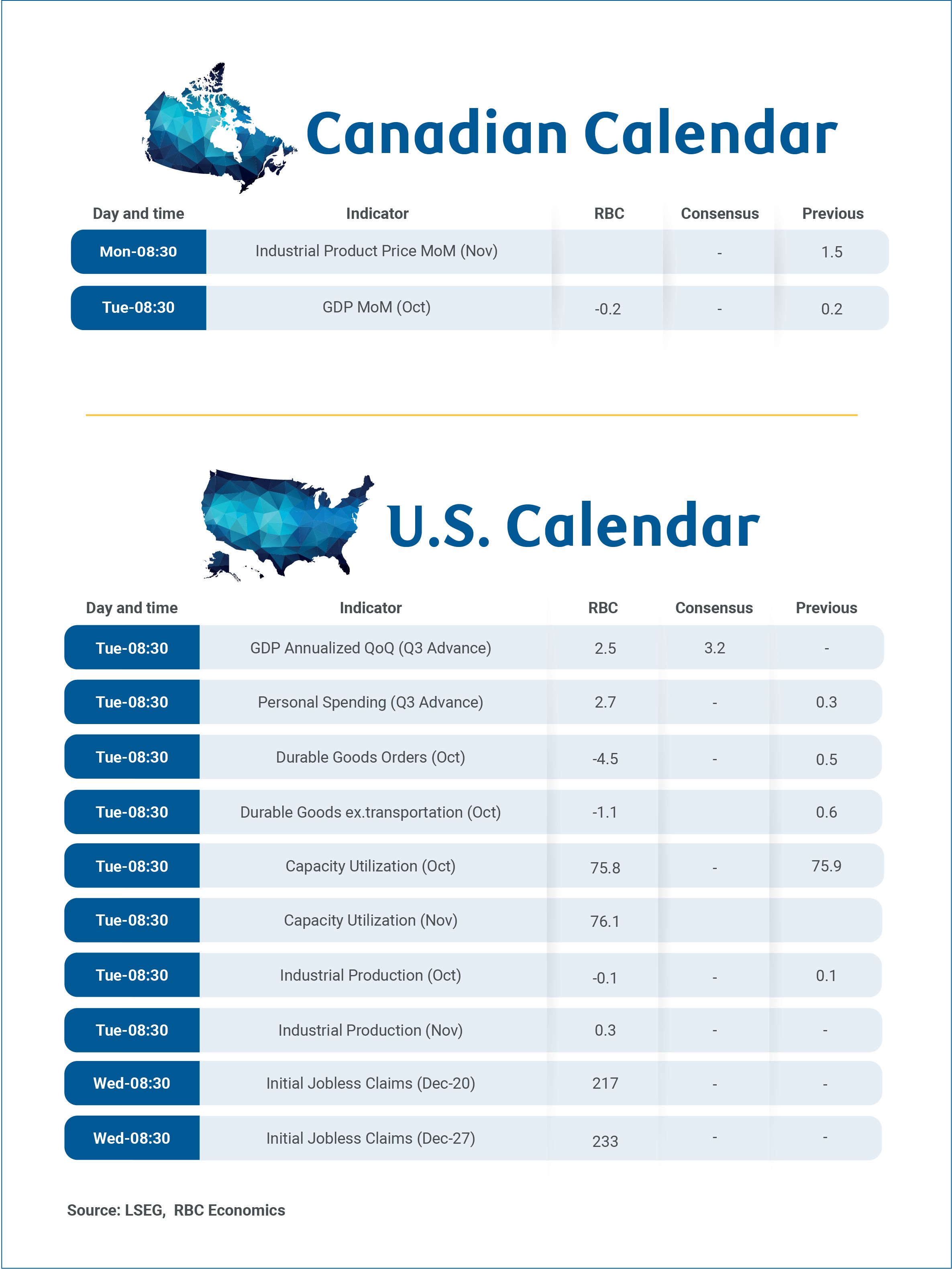For weeks of Dec. 22 and Dec. 29
Canada’s gross domestic product report for October on Tuesday will mark Statistics Canada’s final major data release of 2025, and we anticipate a 0.2% decline in growth.
It’s slightly higher than StatsCan’s preliminary estimate released a month earlier for a 0.3% contraction. If October’s decline is realized, it would represent the steepest monthly drop in GDP since February.
Still, early indicators such as hours worked and our tracking of consumer spending suggest a possible recovery in November. We continue to expect a soft 0.5% annualized increase in GDP for Q4.
In October, we see weakness mostly from goods-producing sectors, while output among service industries remained essentially unchanged.
Non-conventional oil production in Alberta contracted sharply (-5%) in October after four consecutive months of expansion. Manufacturing output declined as well, partially reversing September’s gains. StatsCan’s October mineral production data indicated modest recovery in mining output, following declines in the prior two months, helping to cushion some weaknesses in other sectors.
For services, home resales rose 0.8% month-over-month in October, bolstering real estate activity. Arts and entertainment saw a boost from the Blue Jays’ playoff run, although the gain was likely reversed quickly in November. Offsetting stronger activities was the Alberta’s teacher strike temporarily weighing on education services. Wholesale and retail volumes also fell, by 0.7% and 0.6% respectively.
Early November indicators suggest signs of stabilization. Hours worked increased a larger 0.4%, and our tracking of RBC consumer spending data indicates continued strength, especially in discretionary purchases as the holiday shopping season ramps up. This is consistent with StatsCan’s advance retail indicator, which shows sales rebounded by 1.2% in November. Overall, we continue to expect modest growth in Q4.
Week ahead data watch:
-
Delayed Q3 U.S. GDP report will be released on Tuesday after the U.S. government shutdown. We look for headline GDP growth of an annualized 2.5% quarter-over-quarter—a deceleration from Q2’s 3.8%. Much of Q3’s expansion was driven by household consumption, particularly within services. Excluding volatile net trade, final domestic demand likely remained resilient, albeit growing slightly slower than in Q2.

Forward Guidance will be on vacation next week. Happy holidays to our readers!
This report was authored by Senior Economist Claire Fan and Economist Abbey Xu.
Explore the latest from RBC Economics:
Canadian fiscal: Will better growth, delayed spending soften deficit blow?
Quarterly Canadian outlook. More cautious optimism amid structural shifts
U.S. Analysis. November inflation – a gift for Fed Doves but proceed with caution
Podcast: The 10-Minute Take. Three common economic trends in Canada and the U.S. in 2025
Canadian Housing. Stand-off between buyers and sellers leaves Canada’s housing market stuck
U.S. Employment Report. The fog is clearing but crosswinds persist
Canadian Analysis. Canada’s inflation in November steady with mixed details
Share these insights with your network:
This article is intended as general information only and is not to be relied upon as constituting legal, financial or other professional advice. The reader is solely liable for any use of the information contained in this document and Royal Bank of Canada (“RBC”) nor any of its affiliates nor any of their respective directors, officers, employees or agents shall be held responsible for any direct or indirect damages arising from the use of this document by the reader. A professional advisor should be consulted regarding your specific situation. Information presented is believed to be factual and up-to-date but we do not guarantee its accuracy and it should not be regarded as a complete analysis of the subjects discussed. All expressions of opinion reflect the judgment of the authors as of the date of publication and are subject to change. No endorsement of any third parties or their advice, opinions, information, products or services is expressly given or implied by Royal Bank of Canada or any of its affiliates.
This document may contain forward-looking statements within the meaning of certain securities laws, which are subject to RBC’s caution regarding forward-looking statements. ESG (including climate) metrics, data and other information contained on this website are or may be based on assumptions, estimates and judgements. For cautionary statements relating to the information on this website, refer to the “Caution regarding forward-looking statements” and the “Important notice regarding this document” sections in our latest climate report or sustainability report, available at: https://www.rbc.com/community-social-impact/reporting-performance/index.html. Except as required by law, none of RBC nor any of its affiliates undertake to update any information in this document.


